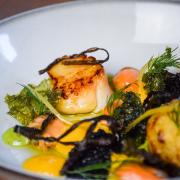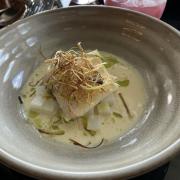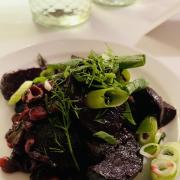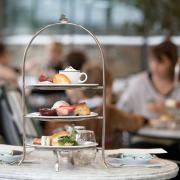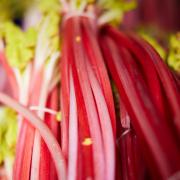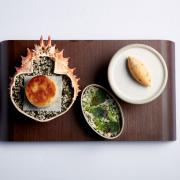A crash course in the fine old art of chutney making by a man who knows his onions (and tomatoes and elderberries…)

Jars high and low are crammed together on Peter Banks’ table. Seen from above they look like a futuristic city skyline – Manhattan rendered in chutney. Here in this tall coffee jar is apple and chilli chutney; over there in that squat jam jar is elderberry. Squashed somewhere in the middle is some damson ketchup. With colours ranging from deep browns to ruby reds to glistening golds, these home-made preserves are almost a work of art.
And they don’t taste bad either. Peter gives photographer Andy Bulmer and me a spoon each and we set about the jars, getting a different hit from each one: the sweetness of the plum jelly, the heat of the apple and chilli, the varying intensity of two marrow chutneys, one made with distilled vinegar and Demerara sugar. Washed down with coffee it was quite the most interesting elevenses, ever.
While we slurped and nodded our approval, Peter explained how he became a chutney champion. ‘It all started off because I am tight and I don’t like waste,’ he said. ‘I started by growing my own tomatoes. Then you see everything else that’s just falling down. I used to live in Spofforth. It was full of apple trees. It seems like such a waste that people don’t do anything with them.’
Peter developed a large veg patch in the grounds of another former home in North Yorkshire which provided everything from pumpkins to fennel to crimson kale. Tomatoes grew in the greenhouse. But the joy of chutney is you don’t need a big garden to lay your hands on free ingredients, said Peter. Railway embankments and roads are a happy hunting ground. Apple cores thrown from moving cars seed trees which in turn produce a crop of their own. ‘I’m always stopping on the side of the road. One place was littered with crab apples.’

Among his creations is hedgerow chutney, a fine preserve from the fruits of raided roadside hedges. It’s all there if you know where to look. ‘A generation ago everyone would have done this,’ said Peter. ‘Now we are such a wasteful society. I started doing this many years before it became hip and trendy. Everybody used to think it was weird, but first, it saves money and second, it’s a lovely thing to do.
‘It keeps you in touch with what’s growing. In spring I look for the flowers on the trees so I can see where the fruit trees are, then I come back to them in the autumn.’ His father brought him up to appreciate the natural world. ‘We lived down south. He was a country boy through and through. He would say, “this is a rowan tree this is a mountain ash, this is a sycamore, this is an oak”.’ Peter’s children are picking up by osmosis, he says.
Sourcing ingredients for his jellies and chutneys also makes him more aware of the seasons. As managing director of Rudding Park Hotel, Harrogate, Peter and consultant chef Stephanie Moon have been working to ensure their menus are filled with local, seasonal ingredients.
‘Most city dwellers have lost touch with this and it our own fault,’ said Peter. ‘If you asked most people when does asparagus come out they wouldn’t know. The first taste of an English strawberry is something special. You shouldn’t be able to buy strawberries all year round.’

Peter, 46, has been influenced by all branches of his family. He uses his grandfather’s jam pot to make damson jelly and recalled how ‘my great aunt lived till she was 106. She was a gamekeeper’s daughter. She had a recipe for cowslip wine – when did you last see a cowslip? The recipe says “pick a trug full of cowslips”. If we’re not careful, we’ll lose touch fully with what’s going on.’
A trained chef, Peter once worked in the kitchens at London’s Savoy. ‘It was the hardest I have worked in my life. I went down to nine and a half stone. I am 6ft 3ins – it was brutal.’
Later he ran a restaurant in Suffolk which was the first to put food miles on the menu and didn’t use any ingredient that came from over 100 miles away. But you don’t have to be much of a cook to make chutney, he insisted. He occasionally consuls the Secrets from the WI book and swears by Delia’s text to see if a mixture in the pot can be cooled and bottled – ‘run a wooden spoons through it. If the channel remains still and doesn’t fall in, that’s ready’. Otherwise, he is a trial and error man.
Take apple chutney for example. He’s no idea what sort of apples are in it. ‘Don’t core them or peel them just chuck ‘em in a pan, boil them, strain them in a couple of old tea towels and hang ‘em off a bar stool,’ he said. ‘You mustn’t squeeze – if you squeeze them you don’t get a clear jelly.
‘For every pint of juice, add a pound of sugar. Let it go off the boil before adding chilli or other ingredients otherwise the will sink to the bottom of the jar. And that’s about it.’
He finds his chutney sessions a release from the pressure of a demanding job. ‘It gets me out in the fresh air, connects me with nature, I don’t have to talk with people – you are out there on your own. A lot of what I do is ephemeral – now you see it, now you don’t. This is really creating something.’
Yorkshire Life Chutney
While we were there Peter began creating a new chutney from tomatoes he’d just picked in the greenhouse. A few days later he emailed me an update…
‘My Yorkshire Life Chutney was bottled last night – I didn’t put as much vinegar in – it was about one pint to two pounds of sugar. It therefore has quite a jammy consistency.
The recipe
3 or 4lbs of tomatoes (mixed colours)
7 red onions
6 or 7 cooking apples (picked from the tree in the dark by the headlights of my car when I got home from work)
A decent dash of chilli powder, star anise and allspice
1lb white sugar
1lb of dark sugar
‘It has made a really deep coloured, unctuous goo, that already tastes great. The tomato seeds are still visible throughout, which add a nice counterpoint to the chutney. It only made four jars (old medium-sized Nescafe ones) though.’




